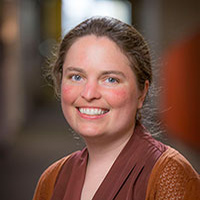By Andrew J. Bernoff and Ursula Whitcher
Big data and underrepresentation of women in the mathematical sciences are two hot topics in the applied mathematics community. Chad Topaz and Shilad Sen, enterprising researchers at Macalester College, are using cutting-edge data collection and analysis techniques to study the shortage of women in mathematics, specifically on the editorial boards of mathematics journals [4]. Mathematical journal editors are an interesting cross between mentors and gatekeepers of academic success; a strong publication record is necessary to flourish in most faculty settings, and a supportive editor can be the difference between an article publishing speedily in a top-notch journal or never appearing in a public venue.
Topaz and Sen argue that women are underrepresented on mathematical editorial boards relative to the proportion of women ladder faculty at research universities. They also find that the editorial boards of SIAM journals have significantly more women editors than their counterparts, perhaps even more than might be expected from unbiased choice among the available academics.
To understand what this means, one must explore the so-called “leaky pipeline” of academia. This idiom is meant to capture the slow loss of women along the academic ladder, from entering college to obtaining a tenure track faculty position, followed by achieving some of the hallmarks of success in that position, such as being asked to edit an academic journal in one’s specialty area. We live in an era where 58% of all bachelor’s degrees awarded in the United States are conferred on women [5]. Specifically, women receive 41% of U.S. bachelor’s degrees [5] and 31% of new Ph.D.s in the mathematical sciences [2]. They hold 31% of the full-time positions in mathematics and statistics, but constitute only 16% of ladder faculty at doctoral-granting institutions [1]. SIAM membership appears to be comparable to that of ladder faculty; merely 15% of the non-student members who report their gender are female [3].
Topaz and Sen estimate that 8.9% of editorships at mathematics journals are held by women. Editors, they write, “act as stewards who ensure the quality of research being reported and whose editorial decisions even influence the broad course of research within the community,” and note that “women excluded from editorial board membership do not have access” to the associated “opportunities for intellectual growth” and professional networks [4]. They suggest this poses potential harm not only to individual women who are overlooked, but to the vibrancy of the field as a whole.
The study samples 13,067 editorships (since some people are editors of multiple journals, the number of distinct individuals serving on mathematical editorial boards will be smaller). How does one identify the gender of a mathematical editor? After all, journals do not usually publish the demographics of their editorial boards.
Topaz and Sen used an innovative hybrid approach to obtain this information. For approximately half the editorships in their database, they were able to assign a gender of male or female with high confidence using the genderize.io database. The other half required further research. However, instead of making educated guesses on their own, Topaz and Sen crowdsourced their investigation through Amazon’s Mechanical Turk platform. For each editorship, five different Mechanical Turk contractors (known as Turkers) independently researched the person and reported both a gender (male, female, non-binary, or unable to determine) and a degree of confidence in the gender assessment.
Mechanical Turk allows many people to contribute small amounts of labor to a project. This work isn’t free, and the eventual price tag for identifying editors and assessing gender came to roughly $15,000. Topaz and Sen obtained a seed grant of $4,950 from Macalester College to prototype their project, but struggled to find further funding. “Most agencies didn’t answer” or could not quickly fund this type of project, Sen recalls. Finally, the pair decided to turn to crowdfunding, through the website experiment.com. They were “shocked” by the mathematics community’s enthusiastic response, Topaz says. “It took a week to meet our initial funding goal. Clearly we struck a nerve. Our colleagues in the scientific community apparently care deeply about this issue.”
After collecting the data, Topaz and Sen looked for factors associated with a rate of women’s editorships higher or lower than the “background rate” of 8.9%. They found that applied mathematics in general, and SIAM publishing in particular, were both associated with greater representation of women. “Within the pool of editorships on journals classified as applied, representation of women is 10.3%,” they write [4]. Women editorships made up 7.2% of pure mathematics journals, while journals classified as publishing both pure and applied mathematics were at 7.4%. With 19.9% women editorships, SIAM was “the only publisher that is [statistically] significantly higher than the background level” (see Figure 1). Another professional society, the American Mathematical Society, came in second at 16.3% [4].
Figure 1. A graphical representation of the leaky pipeline for women in mathematics. Whereas women receive 58% of bachelor’s degrees awarded in the U.S., the percentage of bachelor’s in the mathematical sciences declines to 41% and the percentage of Ph.D.s to 31%. While women represent 31% of full-time faculty in the mathematical sciences, they make up only 16% of the ladder faculty at doctoral-granting institutions, which is comparable to the percentage of female non-student members at SIAM (15%). While Topaz & Sen estimate that mathematics journals in general have only about 9% of editorships held by women, SIAM journals have a significantly higher percentage of women editorships (nearly 20%). SIAM Review is particularly impressive; 43% of its editors are women. Image credit: Andrew Bernoff.
What makes SIAM publications stand out? One possibility is that women are more highly-represented in applied mathematics than pure mathematics. “My guess is that the applied mathematics business has greater gender diversity as a community than other parts of science and engineering,” says C.T. Kelley, a professor at North Carolina State University, editor of multiple SIAM journals, and chair of the SIAM Board of Trustees. Statistics do support this hypothesis at the Ph.D. level. The AMS Report on the 2014-2015 New Doctoral Recipients (the most recent data currently available) shows that 33.9% of new Ph.D. recipients in applied mathematics, 41.4% in statistics and biostatistics, 56.2% in mathematics education, and 23.4% in the remaining “pure” mathematics categories are women [2]. But we have already observed that the demographics of ladder faculty in Ph.D.-granting departments are different from the demographics of new Ph.D.s; we do not know whether the greater proportion of women in applied mathematics as compared to pure mathematics at the Ph.D. level extends to the pool of likely editorships.
Another possibility is that professional societies are more committed to diversity than commercial publishers. When we asked editors of SIAM journals about gender on their editorial boards, many commented that gender was one of multiple factors (including race, geographic distribution, seniority, subfield, and industrial versus academic employment) they considered when striving for a diverse editorial board. “There are different types of diversity, and while the single most important diversity is being able to cover all the research topics in applied math, SIAM makes it very clear in the guidelines that non-mathematical diversity is also important,” says Evelyn Sander, a professor at George Mason University who serves as section editor of SIAM Review and associate editor of the SIAM Journal on Applied Dynamical Systems.
Looking forward, this study and our interviews suggest some best practices for constructing and maintaining editorial boards. Assembling a large list of potential editors (generated with broad input from the target readership) facilitates the selection of a diverse editorial board. Additionally, Topaz and Sen’s work serves as a compelling argument for documenting how editors (and more broadly, mathematicians) self-identify in terms of gender, race, and ethnicity.
References
[1] American Mathematical Society. (2016, February). Fall 2014 Departmental Profile Report. Available from http://www.ams.org/profession/data/annual-survey/2014Survey-DepartmentalProfile-Report.pdf.
[2] American Mathematical Society. (2016, August). Report on the 2014-2015 New Doctoral Recipients. Available from http://www.ams.org/profession/data/annual-survey/docsgrtd.
[3] Society for Industrial and Applied Mathematics. (2016, July). SIAM Annual Business Meeting – July 2016. Available from https://www.siam.org/about/pdf/2016annualreport.pdf.
[4] Topaz, C.M., & Sen, S. (2016). Gender Representation on Journal Editorial Boards in the Mathematical Sciences. PLOS One, 11(8), e0161357.
[5] United States Department of Education, Institute of Education Sciences, National Center for Education Statistics. (2014). The Integrated Postsecondary Education Data System Completions Survey. Available from https://ncsesdata.nsf.gov/webcaspar.

|
Andrew Bernoff is the Diana & Kenneth Jonsson Professor of Mathematics at Harvey Mudd College. He specializes in applying dynamical systems to experiments in physics and biology and is passionate about undergraduate education, mentoring undergraduate research, and helping students find careers and pursue graduate studies in applied mathematics. |
 |
Ursula Whitcher is an associate editor at Mathematical Reviews and an associate professor at the University of Wisconsin-Eau Claire. Her research interests include geometry associated with string theory and the representation of women in mathematics subfields. |